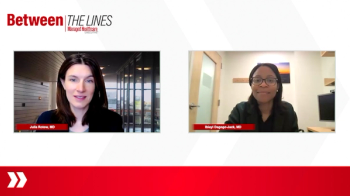
Patient Considerations for Ruxolitinib in Vitiligo Treatment
Experts review which patients with vitiligo they would consider using ruxolitinib in.
Episodes in this series

Dr. Heather Woolery-Lloyd: Renata, in your practice, which patients with vitiligo do you consider using ruxolitinib in?
Renata Block: I offer it to all patients with nonsegmental vitiligo, and we want to use it for up to 10% body surface area. I always take an extensive medical history for the patient (with regard) to what they have used in the past, what treatment failures they had and the duration of treatment. All that documentation is obviously very important. Also being transparent (about) the risks with the JAK (Janus kinase) inhibitor itself (with regard) to increased risk of infections, what their TB (tuberculosis) history is, because you know they’re going to come home with the package insert, read it and be intimidated by it. It’s something that I explain to the patient at the visit. I open the door for the continued conversation after the visit because it can be very intimidating when they start reading that package insert about these potential side effects that can happen. That is why I go into detail with the extensive history (with regard) to how healthy they are, when’s the last time they had any blood tests or did they see a primary care physician? That goes with all my dermatology visits, having the patient have an internist or a primary care physician that they go see regularly. A lot of times these patients don’t go for an annual physical exam, and they’re walking time bombs. They have a diagnosis, maybe diabetes or some other things that they don’t even know of until I force them to go and get checked out. Bottom line is, anybody who is a candidate, I open that door, and I think it’s an exciting time to offer our patients a treatment that is FDA approved, that is working, and they come back with repigmentation. It’s just such an exciting time for us.
Dr. Heather Woolery-Lloyd: It really is, especially for those of us who treat a lot of pigmentary disorders. It really is nice to have something new and that’s effective. (Dr. Kindred), I want to ask you a little bit more about how ruxolitinib fits into your treatment pathway, but also, how do you address the black box label? How do you discuss those risks with the patients?
Dr. Chesahna Kindred: Patients are really intelligent, so I actually tell them the data. How it fits. Ruxolitinib is now my go-to. We start with ruxolitinib, and my patients are definitely happy with the results that they’re seeing. Regarding the black box warning, I point out that that label started with a different JAK inhibitor; it was oral, and the label got extended to everything in the class. Patients understand that. They went through that with the calcineurin inhibitors, as they’re not new to it. It’s not that big of a discussion. Particularly because it’s topical. It’s not a huge elephant in the room for us at all.
Dr. Heather Woolery-Lloyd: Yes. I do use that same approach. I go through everything. I ask for relevant medical history just to make sure that there aren’t any big red flags as far as medical history. If someone is a smoker and has a lot of other confounding big medical problems, we might go into more detail. But I will say, most of my vitiligo patients are young, healthy people. In general, those are the types of patients who are coming in for treatment. They’re patients who didn’t have treatment options before. A lot of the patients that I’m seeing are not newly diagnosed vitiligo patients, but patients like you said, who are smart and are reading and are learning that there is a new treatment option available. In my practice, I have not had as much of an issue with the risks because they tend to be younger and healthier.
Renata Block: I have to agree with that. The same goes for my practice as well. But they’re savvy. They know things. They read a lot and believe it or not, they’ll come back with those questions and concerns. Being transparent and forefront with the information builds that trust with you. When they come back and see the results, it’s just makes it so much better.
Dr. Heather Woolery-Lloyd: Yeah, I agree. I think it’s so important to be transparent. I do like to be proactive. I talk a lot with my patients, probably a little too much. I’m always running behind. But I think it’s important to really have these discussions so that we can answer questions in advance.
Transcript edited for clarity.
Newsletter
Get the latest industry news, event updates, and more from Managed healthcare Executive.















































